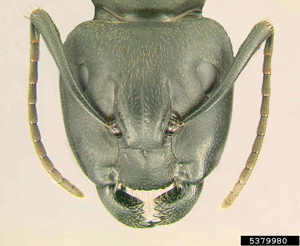Are Carpenter Ants Different From Other Ants?
By Chris Williams on September 4, 2014.
We’ve had an on-again, off-again ant problem for more than a year. A friend suggested that these could be carpenter ants. Ants don’t concern me much but should I be worried about carpenter ants? D. F., Georgetown, MA
 The main way that carpenter ants are different from other ants is that they like to nest inside wood, especially wood that is damp or has been water-damaged. They don’t eat the wood, but they dig it out with their strong jaws to make their nest galleries. While their presence may not concern you (and you may not even see the ants that often), what may be going on behind your walls probably should concern you.
The main way that carpenter ants are different from other ants is that they like to nest inside wood, especially wood that is damp or has been water-damaged. They don’t eat the wood, but they dig it out with their strong jaws to make their nest galleries. While their presence may not concern you (and you may not even see the ants that often), what may be going on behind your walls probably should concern you.
First, Make Sure You’ve Got the Right Ant
That said, the first thing you should do is find out whether or not you are really dealing with carpenter ants. An exterminator or an entomologist can identify them for you. Carpenter ants are quite large and either completely black, or black and red in color. The next thing is to find out where the ants are nesting; that’s not an easy thing to do and usually requires the services of a professional exterminator (see Finding the Source of Carpenter Ants).
You want to find the nest site, or sites, because the ants may not necessarily be nesting inside your home. They could be foraging in from the outside to pick up crumbs in your kitchen. However, if you have been seeing them inside year-round, that’s a pretty good indication that the nest is inside. In either case (and no matter the ant), a professional can set up a baiting program that will eliminate the ants and the nest.
Have You Noticed These Carpenter Ant Clues?
If you’ve had a carpenter ant nest in your home for some time, you may have seen the winged swarmer ants that emerge from the nest in the spring or summer. Other signs of a carpenter ant nest are “dump piles” below the nest site. These piles contain bits of excavated wood and other debris, along with dead ants or other insects, that are pushed out of the nest (see Sawdust Piles Could Mean Carpenter Ants). There may be crinkling or rustling sounds from the nest site.
Usually, you can’t even detect the wood damage without opening up the area. The wood may appear fine on the surface but inside it can be almost completely hollowed out with ant galleries. Carpenter ant damage to wood is usually not as serious as termite damage, but it’s not something you want to ignore either (see Carpenter Ant Damage to Wood – How Bad Can it Be?). The longer the colony has been present, the more likely that there will be structural wood damage. Don’t gamble with the value of your home, call Colonial today.
Image: Gary Alpert, Harvard University, Bugwood.org